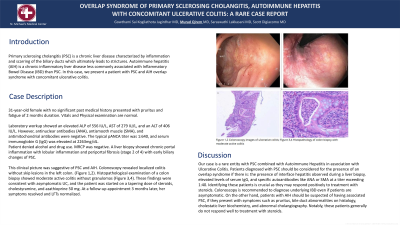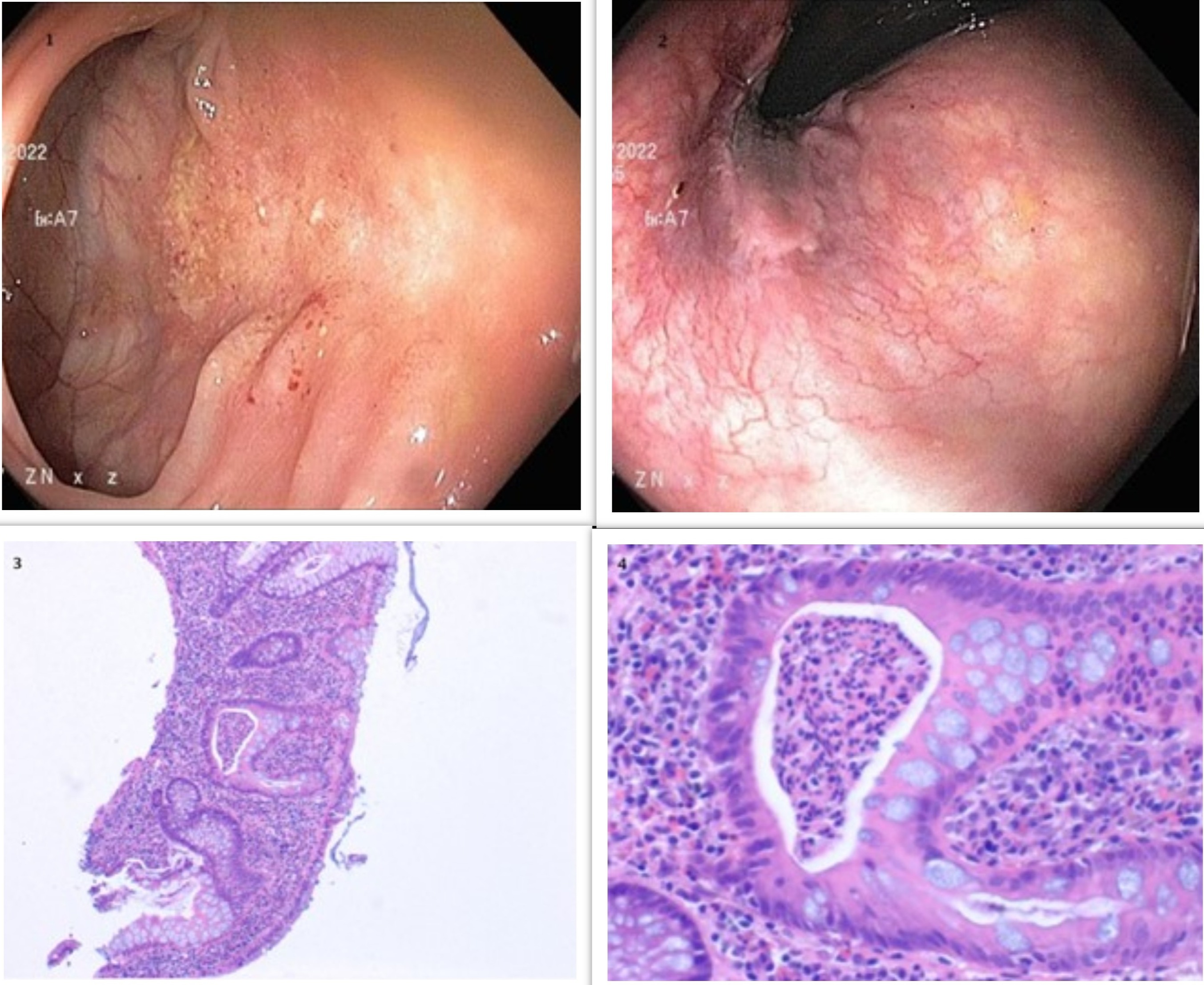Tuesday Poster Session
Category: Biliary/Pancreas
P2989 - Overlap Syndrome of Primary Sclerosing Cholangitis, Autoimmune Hepatitis with Concomitant Ulcerative Colitis: A Rare Case Report
Tuesday, October 24, 2023
10:30 AM - 4:00 PM PT
Location: Exhibit Hall

Has Audio

Gowthami Sai Kogilathota Jagirdhar, MD
Saint Michael's Medical Center
Newark, NJ
Presenting Author(s)
Gowthami Sai Kogilathota Jagirdhar, MD1, Murad Qirem, MD1, Saraswathi Lakkasani, MD2, Scott Digiacomo, MD1
1Saint Michael's Medical Center, Newark, NJ; 2Saint Michael's Medical Center, New York Medical College, Newark, NJ
Introduction: Primary sclerosing cholangitis (PSC) is a chronic liver disease characterized by inflammation and scarring of the biliary ducts which ultimately leads to strictures. Autoimmune hepatitis (AIH) is a chronic inflammatory liver disease less commonly associated with Inflammatory Bowel Disease (IBD) than PSC. In this case, we present a patient with PSC and AIH overlap syndrome with concomitant ulcerative colitis.
Case Description/Methods: A 31-year-old female with no significant past medical history presented with pruritus and fatigue of 2 months duration. Vitals and Physical examination are normal. Laboratory workup showed an elevated ALP of 556 IU/L, AST of 279 IU/L, and an ALT of 406 IU/L. However, antinuclear antibodies (ANA), anti-smooth muscle (SMA), and antimitochondrial antibodies were negative. The typical pANCA titer was 1:640, and serum immunoglobin G (IgG) was elevated at 2263mg/dL. Patient denied alcohol and drug use. MRCP was negative. A liver biopsy showed chronic portal inflammation with lobular inflammation and periportal fibrosis (stage 2 of 4) with early biliary changes of PSC. This clinical picture was suggestive of PSC and AIH. Colonoscopy revealed localized colitis without skip lesions in the left colon. (Figure 1,2). Histopathological examination of a colon biopsy showed moderate active colitis without granulomas (Figure 3,4). These findings were consistent with asymptomatic UC, and the patient was started on a tapering dose of steroids, cholestyramine, and azathioprine 50 mg. At a follow-up appointment 3 months later, her symptoms resolved and LFTs normalized.
Discussion: Our case is a rare entity with PSC combined with Autoimmune Hepatitis in association with Ulcerative Colitis. Patients diagnosed with PSC should be considered for the presence of an overlap syndrome if there is: the presence of interface hepatitis observed during a liver biopsy, elevated levels of serum IgG, and specific autoantibodies like ANA or SMA at a titer exceeding 1:40. Identifying these patients is crucial as they may respond positively to treatment with steroids. Colonoscopy is recommended to diagnose underlying IBD even if patients are asymptomatic. On the other hand, patients with AIH should be suspected of having associated PSC, if they present with symptoms such as pruritus, bile duct abnormalities on histology, cholestatic liver biochemistry, and abnormal cholangiography. Notably, these patients generally do not respond well to treatment with steroids.

Disclosures:
Gowthami Sai Kogilathota Jagirdhar, MD1, Murad Qirem, MD1, Saraswathi Lakkasani, MD2, Scott Digiacomo, MD1. P2989 - Overlap Syndrome of Primary Sclerosing Cholangitis, Autoimmune Hepatitis with Concomitant Ulcerative Colitis: A Rare Case Report, ACG 2023 Annual Scientific Meeting Abstracts. Vancouver, BC, Canada: American College of Gastroenterology.
1Saint Michael's Medical Center, Newark, NJ; 2Saint Michael's Medical Center, New York Medical College, Newark, NJ
Introduction: Primary sclerosing cholangitis (PSC) is a chronic liver disease characterized by inflammation and scarring of the biliary ducts which ultimately leads to strictures. Autoimmune hepatitis (AIH) is a chronic inflammatory liver disease less commonly associated with Inflammatory Bowel Disease (IBD) than PSC. In this case, we present a patient with PSC and AIH overlap syndrome with concomitant ulcerative colitis.
Case Description/Methods: A 31-year-old female with no significant past medical history presented with pruritus and fatigue of 2 months duration. Vitals and Physical examination are normal. Laboratory workup showed an elevated ALP of 556 IU/L, AST of 279 IU/L, and an ALT of 406 IU/L. However, antinuclear antibodies (ANA), anti-smooth muscle (SMA), and antimitochondrial antibodies were negative. The typical pANCA titer was 1:640, and serum immunoglobin G (IgG) was elevated at 2263mg/dL. Patient denied alcohol and drug use. MRCP was negative. A liver biopsy showed chronic portal inflammation with lobular inflammation and periportal fibrosis (stage 2 of 4) with early biliary changes of PSC. This clinical picture was suggestive of PSC and AIH. Colonoscopy revealed localized colitis without skip lesions in the left colon. (Figure 1,2). Histopathological examination of a colon biopsy showed moderate active colitis without granulomas (Figure 3,4). These findings were consistent with asymptomatic UC, and the patient was started on a tapering dose of steroids, cholestyramine, and azathioprine 50 mg. At a follow-up appointment 3 months later, her symptoms resolved and LFTs normalized.
Discussion: Our case is a rare entity with PSC combined with Autoimmune Hepatitis in association with Ulcerative Colitis. Patients diagnosed with PSC should be considered for the presence of an overlap syndrome if there is: the presence of interface hepatitis observed during a liver biopsy, elevated levels of serum IgG, and specific autoantibodies like ANA or SMA at a titer exceeding 1:40. Identifying these patients is crucial as they may respond positively to treatment with steroids. Colonoscopy is recommended to diagnose underlying IBD even if patients are asymptomatic. On the other hand, patients with AIH should be suspected of having associated PSC, if they present with symptoms such as pruritus, bile duct abnormalities on histology, cholestatic liver biochemistry, and abnormal cholangiography. Notably, these patients generally do not respond well to treatment with steroids.

Figure: Figure 1,2 Colonoscopy images of ulcerative colitis; Figure 3,4 Histopathology of colon biopsy with moderate active colitis
Disclosures:
Gowthami Sai Kogilathota Jagirdhar indicated no relevant financial relationships.
Murad Qirem indicated no relevant financial relationships.
Saraswathi Lakkasani indicated no relevant financial relationships.
Scott Digiacomo indicated no relevant financial relationships.
Gowthami Sai Kogilathota Jagirdhar, MD1, Murad Qirem, MD1, Saraswathi Lakkasani, MD2, Scott Digiacomo, MD1. P2989 - Overlap Syndrome of Primary Sclerosing Cholangitis, Autoimmune Hepatitis with Concomitant Ulcerative Colitis: A Rare Case Report, ACG 2023 Annual Scientific Meeting Abstracts. Vancouver, BC, Canada: American College of Gastroenterology.
